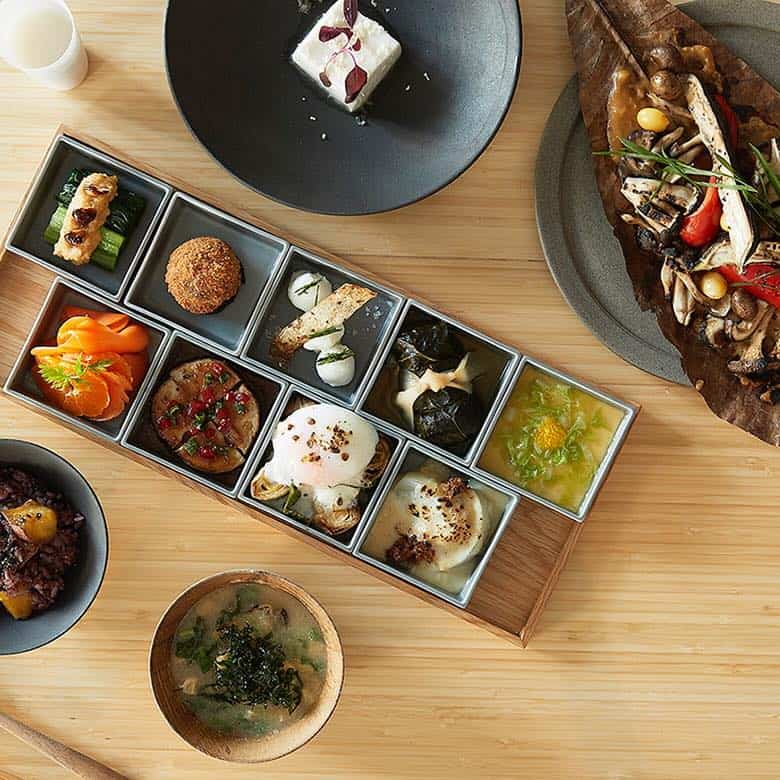While foreign travel offers exciting opportunities to sample unfamiliar foods, those with dietary restrictions such as gluten intolerance know that navigating a menu can sometimes be a challenge.
Although a gluten-free diet is not particularly common in Japan, more restaurants and grocery stores are starting to offer more options for travelers with special dietary needs. With a little planning, it’s possible to experience new foods while still being mindful of allergies or sensitivities. Read on for some reliable menu choices, helpful phrases and some noted restaurants in Tokyo (see the delicious offerings pictured above from Revive Kitchen Three) and Kyoto that specialize in gluten-free dining.
Phrases to know
Ensuring a meal is free from allergens can be tricky while ordering in a restaurant, especially when there is a language barrier. Here are some key phrases that can help you communicate the ingredients you’re trying to avoid:
Komugi — wheat
Mugi — barley
Shoyu — soy sauce (Shoyu nuki de means “no soy sauce”)
Raimugi — rye
Bakuga — malt
Travelers may find it helpful to bring an allergy card with them to restaurants to better explain their dietary restrictions.
What to avoid
In addition to keeping an eye out for the ingredients mentioned above, it’s important to note that quite a few common Japanese dishes contain gluten, though it may not always be obvious. Soy sauce, or shoyu, is usually made with wheat. While patrons can bring their own packets of gluten-free soy sauce or tamari with them to places like sushi counters, shoyu is used to season dishes fairly often, so diners should inform the restaurant staff of any restrictions before ordering.
Travelers with gluten-free diets should also avoid panko, the breadcrumbs used to make crispy fried meats (tonkatsu), and vegetables and shellfish (tempura). Most noodles like ramen and udon contain wheat, as well as unagi (freshwater eel), because it is usually served with soy-based glaze. Miso paste, a fermented soybean paste used for seasoning, also usually contains wheat, so customers should be wary of soups made with miso-based broth.
How to navigate a menu
While it may seem like there are lots of “off-limits” ingredients, there are many staples of Japanese cuisine that are naturally gluten-free. Take, for example, Japanese sticky rice that is most commonly mixed with rice vinegar, not grain vinegar, or kokoumotsu-su. This means most sushi and sashimi (raw fish) are safe to consume, provided diners bring their own soy sauce and don’t order unagi.
Another common Japanese dish, yakitori (grilled pieces of meat on skewers) is prepared one of two ways — tare (marinated) or shio (seasoned with salt). Gluten-free diners should choose shio, as some marinades may include sauces that contain wheat. Though most noodles should be avoided, soba noodles are made from buckwheat, which, despite the confusing name, is not made of wheat — just make sure the soba is 100% buckwheat and not mixed with other flours.
For dessert, there’s mochi, colorful Japanese rice cakes made of (gluten-free) short-grain rice that comes in a variety of fun flavors.
Where to find gluten-free restaurants
Eateries with gluten-free options are more prevalent in larger cities like Tokyo and Kyoto.
Tokyo travelers can visit Revive Kitchen Three in Aoyama, a natural foods restaurant housed inside of an upscale natural cosmetics boutique and offering a wide selection of gluten-free dishes, including special breads and pastas. Rainbow Bird Rendezvous in Meguro is a small café focused on healthy, seasonal ingredients and even a decadent (gluten-free) chocolate cake.
In Kyoto, Choice restaurant is a mecca for vegans, vegetarians and gluten-free diners. Except for their pasta dishes, everything on the menu is gluten-free, including all seasonings and soup broths. Kushikura Honten in downtown Kyoto is quickly becoming a yakitori hot-spot for people with gluten sensitivities, so the staff is generally familiar with the diet and is able to accommodate by serving most meals as shio-yaki, salt-flavored.
When traveling outside of Japan’s major cities, convenience stores can be a good place to pick up an easy snack since you can scan the packaging for ingredients, rather than try to explain issues to restaurant staff. Unlike their Western counterparts, Japanese convenience stores carry fresh foods like onigiri, rice balls, and hard-boiled eggs, making it easier to pull together a well-rounded meal.
With a little background knowledge and armed with an allergy card, travelers with gluten sensitivities can stay well-fed on a trip Japan.

